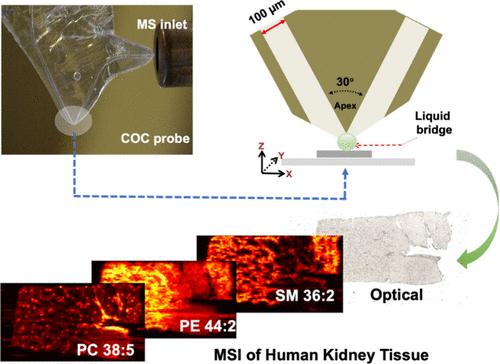A Low-Cost, High-Resolution Thermoplastic Microfluidic Probe for Mass Spectrometry Imaging of Biological Tissue Samples
IF 6.7
1区 化学
Q1 CHEMISTRY, ANALYTICAL
引用次数: 0
Abstract
Mass spectrometry imaging (MSI) using nanospray desorption electrospray ionization (nano-DESI) has been extensively used for label-free mapping of hundreds of molecules in biological samples with minimal sample pretreatment. While both nano-DESI probes made of two fused silica capillaries and glass microfluidic probes (MFP) have been developed for imaging biological tissues with high spatial resolution, MFPs significantly enhance the robustness and throughput of nano-DESI MSI experiments. Despite their advantages, the fabrication of glass microfluidic devices is costly and requires specialized equipment or cleanroom facilities. Meanwhile, plastic microfluidic devices often suffer from limited solvent compatibility and low fabrication precision, restricting their achievable spatial resolution. To overcome these limitations, we have developed a low-cost microfluidic probe made from cyclic olefin copolymer (COC), a widely used thermoplastic material known for its excellent chemical resistance. The probe is fabricated using wire imprinting and thermal bonding in a standard laboratory setting. We estimate the achievable spatial resolution of the COC-MFP of 5–7 μm and demonstrate its robustness by imaging a large (20.0 mm × 9.5 mm) human kidney tissue section with high sensitivity. This affordable thermoplastic probe makes high spatial resolution nano-DESI MSI more accessible, broadening its applications in the scientific community.

用于生物组织样品质谱成像的低成本、高分辨率热塑性微流体探针
使用纳米喷雾解吸电喷雾电离(纳米desi)的质谱成像(MSI)已广泛用于生物样品中数百种分子的无标记制图,只需最少的样品预处理。虽然由两根熔融二氧化硅毛细管制成的纳米desi探针和玻璃微流体探针(MFP)都已被开发用于高空间分辨率的生物组织成像,但MFP显著提高了纳米desi MSI实验的鲁棒性和吞吐量。尽管有这些优点,玻璃微流控装置的制造是昂贵的,需要专门的设备或洁净室设施。同时,塑料微流控器件的溶剂相容性有限,制造精度不高,限制了其可实现的空间分辨率。为了克服这些限制,我们开发了一种低成本的微流体探针,由环烯烃共聚物(COC)制成,COC是一种广泛使用的热塑性材料,以其优异的耐化学性而闻名。探头是在标准的实验室环境中使用线压印和热粘合制造的。我们估计COC-MFP可实现的空间分辨率为5-7 μm,并通过对大(20.0 mm × 9.5 mm)人肾组织切片的高灵敏度成像证明了其鲁棒性。这种经济实惠的热塑性探针使高空间分辨率纳米desi MSI更容易获得,扩大了其在科学界的应用。
本文章由计算机程序翻译,如有差异,请以英文原文为准。
求助全文
约1分钟内获得全文
求助全文
来源期刊

Analytical Chemistry
化学-分析化学
CiteScore
12.10
自引率
12.20%
发文量
1949
审稿时长
1.4 months
期刊介绍:
Analytical Chemistry, a peer-reviewed research journal, focuses on disseminating new and original knowledge across all branches of analytical chemistry. Fundamental articles may explore general principles of chemical measurement science and need not directly address existing or potential analytical methodology. They can be entirely theoretical or report experimental results. Contributions may cover various phases of analytical operations, including sampling, bioanalysis, electrochemistry, mass spectrometry, microscale and nanoscale systems, environmental analysis, separations, spectroscopy, chemical reactions and selectivity, instrumentation, imaging, surface analysis, and data processing. Papers discussing known analytical methods should present a significant, original application of the method, a notable improvement, or results on an important analyte.
 求助内容:
求助内容: 应助结果提醒方式:
应助结果提醒方式:


